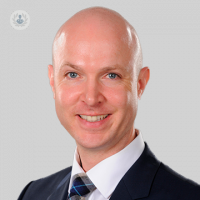BPPV: how is the ear condition diagnosed and treated?
Written in association with:Benign paroxysmal positional vertigo (BPPV) is one of the most common causes of vertigo, an ear condition that causes the false sensation of spinning, loss of balance and feelings of giddiness. BBPV increases with age and particularly affects the elderly population in the UK. Leading ear specialist Professor Owen Judd explains more about the disorder and how it is diagnosed and treated.

How is the ear structured?
There is a tiny organ inside the inner ear which is known as the vestibular labyrinth. This contains three loop-shaped structures, or semi-circular canals containing a fluid which detects rotation of the head. It also contains the otolith organs, small structures with chalk-like crystals on the surface, which detect movement against gravity.
What causes BBPV?
BBPV is a problem that occurs in the inner ear. Some of the crystals of the otolith organs become dislodged and move into one or more of the fluid-filled semi-circular canals.
When enough of these crystals are dislodged in one of the canals, they interfere with normal fluid movement. This, in turn, causes the canal to become sensitive to head position changes that it would not normally respond to and leads to symptoms such as dizziness and feelings of loss of balance.
What are the risk factors for BPPV?
The condition can be associated with head trauma from either a minor bang to the head that you may have forgotten about or a severe blow to the head. Less common causes include disorders that can damage the inner ear, such as an ear infection. Ear surgery or any surgery of the head may be a risk factor. In elderly patients, low levels of vitamin D, osteopenia and osteoporosis have all been linked to the condition.
How is BPPV diagnosed by an ear specialist?
All patients with dizziness should undergo the Dix-Hallpike test to check for BPPV. During this test, the patient will sit upright with legs extended on a couch. The head is then rotated 45 degrees towards the side of the suspected pathology. The patient is then moved into a lying position so that their head hangs slightly below horizontal.
This movement should enable the loose crystals to move within the semi-circular canals. The doctor will ask the patient if they are experiencing any symptoms and will watch how the eyes move. The specialist may test the other side of the head too.
How is BPPV treated?
If the test triggered BPPV symptoms, the doctor will move the head with certain manoeuvres to move the crystals out of the semi-circular canals and into a place where they can be reabsorbed. The patient can practice similar movements and exercises at home for any future flare-ups of BPPV. Simple repositioning manoeuvres are extremely successful as a treatment and rehabilitation exercises are useful.
There are surgical options for treatment of BPPV in severe cases. The specialist may perform a procedure where a bone plug is used to block the portion of the inner ear that is causing the symptoms of vertigo. The plug stops the semi-circular canal from being able to respond to particle movements. However, this surgery is only very rarely required.
Concerned that you have benign paroxysmal positional vertigo? Book now with Professor Judd for a consultation.


